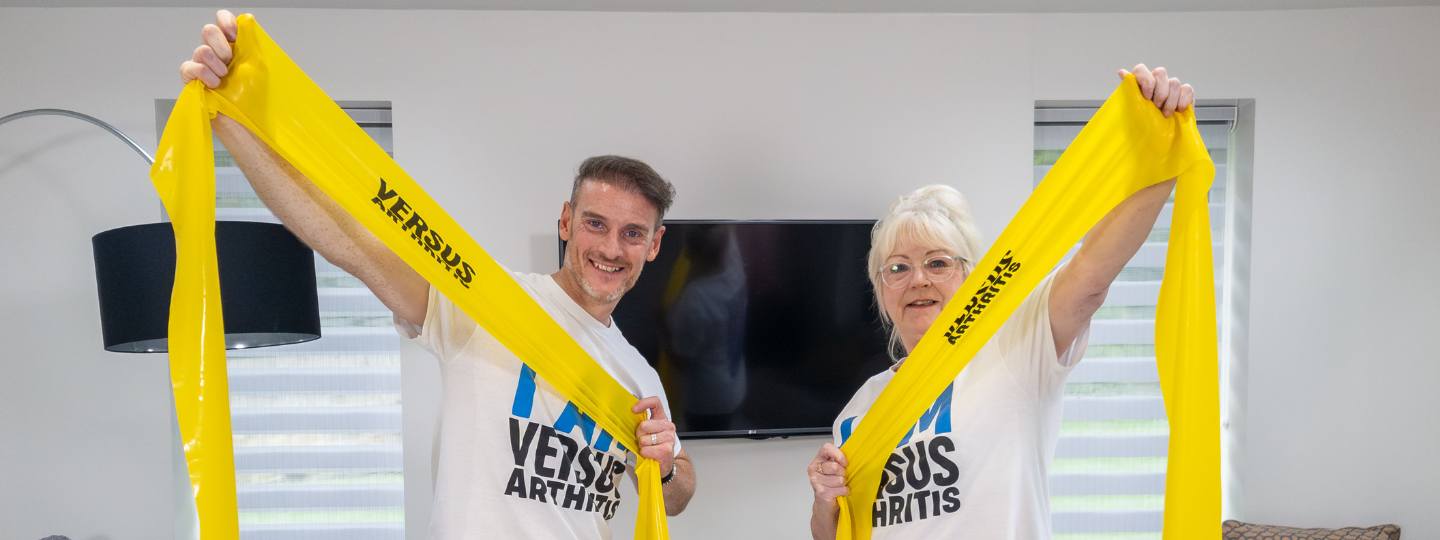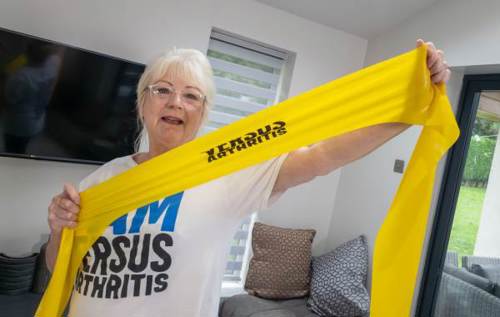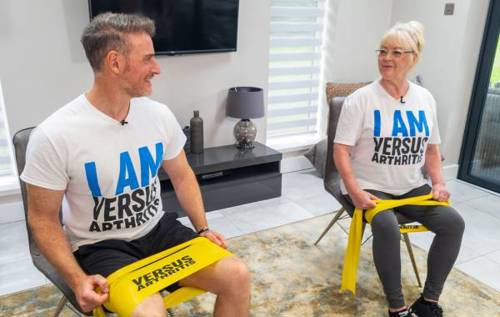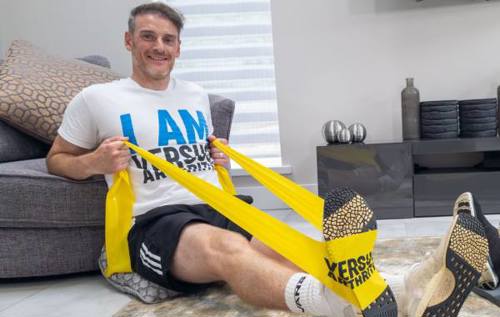Resistance band workouts for people with arthritis
12 February 2024
Exercising with a resistance band can be a great way to build your strength and flexibility.
So, we teamed up with fitness professional, Leon Wormley, and his mum Janet, who lives with arthritis, to create a resistance band workout series. This contains three workout routines, one for your lower body and two for your upper body.
Specially designed for people with arthritis, each follow-along video is packed with simple exercises to help you get moving. There are one lower body and two upper body routines
By taking just a few minutes to do these exercises, it will help to strengthen and stabilise your joints. Plus, it will hopefully make day-to-day activities easier, like going up and down the stairs or carrying your shopping.
What is a resistance band and how do they work?
 It’s recommended that we should do muscle-strengthening exercises twice a week – and using resistance bands is a great way to add these to your routine.
It’s recommended that we should do muscle-strengthening exercises twice a week – and using resistance bands is a great way to add these to your routine.
“Resistance bands are elastic bands that you can use to keep active,” says Leon. Essentially, the force it takes to stretch the band works your muscles in the same way as using weights.
When used correctly, resistance bands can help improve your:
- muscle strength.
- balance.
- flexibility.
- posture.
Resistance bands come in different shapes, sizes, and resistance strengths, so it’s about finding which suits you best.
“You can have a band which has two ends, you can have circular bands, and then there’s resistance bands which have adaptations like handles, which might help support your hands,” explains Leon.
“Some people may struggle gripping the band, so it’s an individual preference about finding what’s comfortable for you.”
Examples of resistance band exercises
There are lots of resistance band exercises you can do from the comfort of your own home.
Check out our resistance band series for some follow-along exercises, specially designed for people with arthritis.
Let's Move Resistance Band Workout Session One: Upper Body
Resistance band benefits
So, what are the benefits of using a resistance band when keeping active?
Convenient
 One of the best parts about resistance bands is that they’re “convenient and effective and you can use them in the comfort of your own home”, says Leon.
One of the best parts about resistance bands is that they’re “convenient and effective and you can use them in the comfort of your own home”, says Leon.
“Even if you’re just waiting for the kettle to boil, you could get your resistance band out and do some strengthening exercises.
“That's one of the big wins, especially if you haven't got the time or confidence to go join a local gym or group.”
Because they’re so lightweight, you can also easily travel and take them with you.
Low impact
A resistance band is a particularly handy item to add to your workout because it’s low impact. This means it won’t put too much pressure or strain on your joints.
Relatively safe
Leon says that resistance bands can also be a “safer option to build strength” because you’re less likely to push your joints too far, which is a real possibility when using weights machines and dumbbells.
By using a resistance band, you can slowly strengthen your muscles and increase your mobility. Eventually, this might make it easier to do day-to-day tasks, like pushing open a door or climbing out of a car.
Affordable and accessible
Resistance bands are relatively affordable and easy-to-find.
“You can get them from pretty much any sports shop, and they’re not too expensive,” says Leon. “You could spend as much, or as little, as you would like on one and if you look after it, it will last year after year.”
Great for different abilities
Resistance bands are great for people of all fitness and abilities, because you can use them while standing or sitting down.
“When I’m stood up and using the resistance band, I’m using more muscle groups because I have to balance as well,” says Leon. “Whereas my mum will sit down and do the movements, which is a bit safer because she’s more stable in that position.”
“If anyone has had a joint replacement and is finding that they have got discrepancies of strength within the body, they can us a resistance band to target a single side. This is great way to address weak areas of the body and reduce any overcompensations".
Let's Move Resistance Band Workout Session Two: Lower Body
How can I grip the band if I have poor mobility in my hands?
If you have painful or achy hands, you might be worried about gripping the band. But Leon says, “there are different ways you can grip it to take the tension out of the wrist or the fingers."
For some exercises, you might want to hold the band in your palm and secure it by putting your thumb on top.
“If your thumb is sore, you might feel a bit of tension there, so you could instead wrap the band around your hand a couple of times to help distribute the load. This will help to take the stress off the fingers,” explains Leon.
“Depending on the exercise, you could even bring the band over the back of your hand and grip it underneath your fingers.”
“One size doesn’t fit all. It’s very much about finding what works for you, and you will only achieve this through experimenting with the different techniques.”
Leon’s exercise tips

Keeping active is vital if you have arthritis as it can help to:
- Reduce your pain.
- Improve your muscle strength.
- Help your balance.
- Improve your energy levels and mood.
- Help you manage your weight.
- Maintain independence.
However, we know that it can sometimes be tough to take that first step. If you haven’t exercised in a while or want to get started, here are Leon’s top tips for getting started:
Choose the right time
“If you’re going through a flare-up, it might not be the right time to start exercising, as you could exacerbate your symptoms,” Leon says. “As a result, you might not enjoy the exercise, feel demotivated and have a poor association with exercise.
“Exercise will not make arthritis worse. It will help you to better manage your symptoms. So, listen to your body and start when you’re ready.”
Start slow and steady
When you’re adding more movement into your life, Leon recommends starting off slow.
“It’s important to build the foundations of fitness first, focusing on your mobility, stability, range of movement and balance. Once we have achieved a good level of this throughout the body we can start to load, add resistance and build strength.
“Working slowly, creating time under tension through the working muscles and joints is the safest and most effective way to start exercising.”
Make it a habit
Leon says that it’s important to make physical activity part of your daily routine.
“Movement is medicine! But building up your strength and range of movement doesn’t happen overnight. It has to be a regular occurrence and over time you’ll reap the benefits of it. I promise.”
“We’ve all got commitments and responsibilities and sometimes life just gets in the way of exercise. Injury, illness and flare ups will all cause us to relapse, however, it is important to accept these as a part of life.
“Do not beat yourself up or get disheartened when things aren’t always going to go to plan. Just take your time, try to relax and recover… then get back moving at your earliest opportunity.”
We’re here for you
If you need advice or support, remember you can:
- Call our free helpline on 0800 5200 520
- Chat to our Arthritis Virtual Assistant
- Join our online community
- Stay in touch and follow us on X (Twitter), Facebook and Instagram.
